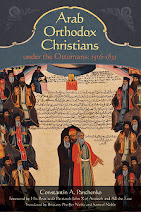Arabic original here.
The Sign of the Cross
Saint Basil the Great says, "In every thing we do, we make the sign of the cross over our faces...This custom did not come from the Bible [that is, literally in the form of a commandment], but holy tradition is what commands this." By this he meant the tradition of the Apostles, as is also the case with our praying toward the East, which is the name of Christ (cf. Zacharia 6:12 LXX) and the custom of triple-immersion in baptism.
In the view of this father and other holy fathers, the sign of the cross contains the two basic dogmas of the Orthodox Church: first, the dogma of the Trinity and second the dogma of the incarnation. We make the sign of the cross by putting together three fingers and then putting the remaining two fingers close to the palm.
First we put our fingers to the forehead, indicating heaven, then to the belly, indicating the earth, then to the right and left shoulders. Please be careful not to make the sign of the cross over your bodies quickly and carelessly. Let us be conscious of remembering the thee Persons, the Father, Son and Holy Spirit, just as we are likewise aware of the other two fingers, Christ's human and divine natures.
Very often, we tie mentioning glory to the Trinity with the sign of the cross when we say "Glory to the Father and to the Son and to the Holy Spirit."
The Evangelist John mentions that Christ indicated the hour of His death when He said, "Now the Son of Man is glorified and God is glorified in Him" (John 13: 31) and "With the glory that He had from the beginning" (John 17:5). In his first epistle, the Apostle Peter speaks of Christ who redeemed the world upon the cross with His precious blood as the sacrificial lamb "foreordained before the foundation of the world" (1 Peter 1:19-20).
Christ crucified is a paschal sacrifice: "Our Pascha is Christ who was crucified for us" (1 Corinthians 5:7).
This is the true meaning of the cross. This is the meaning of the divine liturgy, the divine sacrifice.
To all this we add that very often the sign of the cross is accompanied by a small or large prostration known as a 'metania', which means repentance. The small prostration is bending down to one's knees and the large one is down to the ground. We do this, for example, when we enter the church or when we kiss holy icons.
Beloved, make the sign of the cross with forethought, with understanding, with faith, with absolute hope in Christ crucified who loved us to the point of death on the cross. Make it with determination that you will crucify your passions in order to receive the grace of the Crucified One, that your life may be renewed.
+Ephrem
Metropolitan of Tripoli, Al-Koura and their dependencies
The Sign of the Cross
Saint Basil the Great says, "In every thing we do, we make the sign of the cross over our faces...This custom did not come from the Bible [that is, literally in the form of a commandment], but holy tradition is what commands this." By this he meant the tradition of the Apostles, as is also the case with our praying toward the East, which is the name of Christ (cf. Zacharia 6:12 LXX) and the custom of triple-immersion in baptism.
In the view of this father and other holy fathers, the sign of the cross contains the two basic dogmas of the Orthodox Church: first, the dogma of the Trinity and second the dogma of the incarnation. We make the sign of the cross by putting together three fingers and then putting the remaining two fingers close to the palm.
First we put our fingers to the forehead, indicating heaven, then to the belly, indicating the earth, then to the right and left shoulders. Please be careful not to make the sign of the cross over your bodies quickly and carelessly. Let us be conscious of remembering the thee Persons, the Father, Son and Holy Spirit, just as we are likewise aware of the other two fingers, Christ's human and divine natures.
Very often, we tie mentioning glory to the Trinity with the sign of the cross when we say "Glory to the Father and to the Son and to the Holy Spirit."
The Evangelist John mentions that Christ indicated the hour of His death when He said, "Now the Son of Man is glorified and God is glorified in Him" (John 13: 31) and "With the glory that He had from the beginning" (John 17:5). In his first epistle, the Apostle Peter speaks of Christ who redeemed the world upon the cross with His precious blood as the sacrificial lamb "foreordained before the foundation of the world" (1 Peter 1:19-20).
Christ crucified is a paschal sacrifice: "Our Pascha is Christ who was crucified for us" (1 Corinthians 5:7).
This is the true meaning of the cross. This is the meaning of the divine liturgy, the divine sacrifice.
To all this we add that very often the sign of the cross is accompanied by a small or large prostration known as a 'metania', which means repentance. The small prostration is bending down to one's knees and the large one is down to the ground. We do this, for example, when we enter the church or when we kiss holy icons.
Beloved, make the sign of the cross with forethought, with understanding, with faith, with absolute hope in Christ crucified who loved us to the point of death on the cross. Make it with determination that you will crucify your passions in order to receive the grace of the Crucified One, that your life may be renewed.
+Ephrem
Metropolitan of Tripoli, Al-Koura and their dependencies








No comments:
Post a Comment